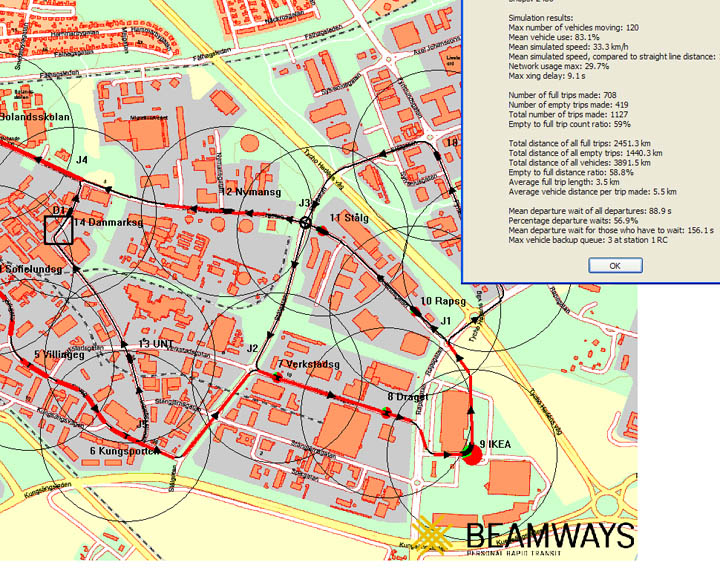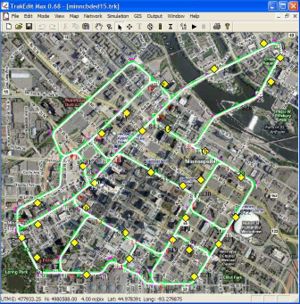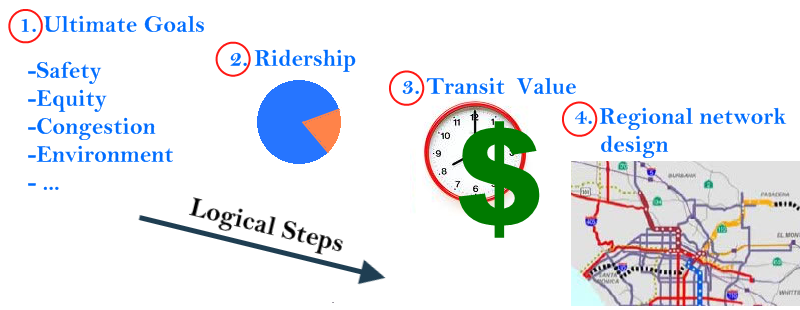Innovative Transport Design, Planning and Operational Simulation Software Packages
There are currently several computer-based software packages that can assist the planning, network design and assessment of operating performance of a various innovative transport technologies.. A brief description of each of them is given below. The first known PRT simulation model of this type was developed by the Aerospace Corporation in the 1970's but is no longer operational. It is described in a book entitled Fundamentals of Personal Rapid Transit by Jack Irving, et al. Others have been developed by the Germans, Japanese, French, British, Americans and others during the past three decades. For a review of these efforts, see the paper entitled "Some History of 32 PRT Simulation Programs", by J.E. Anderson. The most recent work (2000-2011) has been done in the EU and the USA. Hermes, RUF, iTS MAIT, CityMobil and BeamEd are the only software packages that are currently known to be freely available to the public.
Some published results from PRT simulation studies:
Link to an Early View abstract for a paper titled Simulation-based analysis of personal rapid transit: service and energy performance assessment,
by Katharina Mueller and Sgouris P. Sgouridis, forthcoming in the Journal of Advanced TransportationLink to a paper titled Modelling and Simulation of a PRT Network, by Castangia and Guala, 2011, 13 pp.
ATS/CityMobil PRT network design and simulation tool for the ULTra PRT technology (free to the public) ULTra also has a more extensive
in-house program for such work which is proprietary - see www.ultraprt.com for details.Hermes PRT network simulator, by Chris Xithalis (Greece)
A program written in Java with a friendly GUI with which one can:
design a PRT network on a map
set a big variety of parameters (speed,headway,traffic)
simulate it
view statistics and analyses about the simulated system
The web page also features:
a video (in 3 formats) presenting simulator's capabilities
a set of 5 demo networks that can be run online
simulator with manual and demo networks available for download
Version 2.63 is now available at: http://students.ceid.upatras.gr/~xithalis/simulation_en.html
New features:
-Improved empty vehicle management (now empty vehicles may move between stations, improves average waiting time)
-Improved response to emergency situations (= a malfunctioned vehicle that stops on the guideway) and more detailed graphs and reports regarding emergency
-Now one can make slots visible. This is very helpful in order to understand the synchronous clear path control employed by the Hermes simulator.
One can see the moving slots by viewing the simulator or the online demos like this one: http://students.ceid.upatras.gr/~xithalis/online_demo/patras_online_demo.html (requires Java enabled browser)
You have to zoom in on a line, select Line color->Toggle visible slots and press 's' to start simulation.For a study that has used a modified version of Hermes, see the paper Development and Evaluation of Traffic Management Strategies for Personal Rapid Transit
Logistic Centrum's PRTsim Software (Sweden)
About PRTsim
PRTsim is a vendor-independent simulation software suite for generic PRT systems. PRTsim has been developed and improved by prof. Ingmar Andrιasson since 1990 in conjunction with over 50 PRT application studies with up to 17,000 vehicles and 450 stations.
The purpose of PRTsim is to:
design and evaluate network layouts
dimension vehicle fleet and stations
calculate travel standard and productivity
optimize operating strategies
PRTsim has four running modes: Editing, Animation, Batch run and Post-processing.
In Edit mode stations, nodes, links and waypoints are edited by click and drag on an aerial photo or a map.
In Animate mode vehicles and passenger queues can be animated in up to 10 times real speed. Passenger loads are indicated by vehicle colour.
In Batch mode the simulation runs up to 1000 times real speed and results are listed in a file.
In Post-processing, results such as demand, trip ends, flows, waiting and accessibility can be illustrated graphically.
See three examples of graphic displays generated by PRTsimOver the years PRTsim has been augmented with a number of unique options such as:
dynamic decentralized routing with look-ahead
merge priorities to avoid build-up of queues
platooning of empty vehicles to increase link capacity
ride-sharing by adaptable control strategies
empty vehicle management allowing change of destination en route
parallel loading tracks in busy stations
coupled vehicles for increased capacity at peak loads
high-speed links with different headway
bunched transfers from scheduled modes
accessibility analysis showing travel time to a specific destination
PRTsim is used by international consulting firms in cooperation with Andrιasson. New users are welcome, mailto:ingmar@logistikcentrum.se
The software is briefly described in a paper by Dr. Andrιasson published in a 1994 Transportation
Research Record, #1451, pp 95-99. The article is entitled "Vehicle Distribution in Large Personal
Rapid Transit Systems" and is available on-line. It deals extensively with the "empty vehicle management"
problem. Other published studies that have utilized PRTsim software include:
Extending PRT capabilities. Proceedings of the 12th APM
conference in Atlanta, Georgia ASCE 2009
Ride-sharing on PRT. Proceedings of the 10 th APM
Conference in Orlando, Florida ASCE 2005.
Reallocation of PRT Vehicles en Route. Transportation
Research Record, # 1838, TRB 2003.
Quasi-Optimum Redistribution of Empty PRT Vehicles.
Proceedings of the 6th APM Conference in Las Vegas, ASCE 1997.
Demand modelling for PRT competing with bus and car.
Proceedings of the 5th APM Conference in Paris, ASCE 1996.
Vehicle distribution in large PRT systems. Transportation
Research Record #1451 (1995).
Analysis of PRT mixed with buses and trams. Proceedings
of the 27th ISATA Conference in Aachen 1994.
Simulation of large PRT Systems in Sweden, Proceedings of
the 4th APM Conference in Las Colinas, Texas, ASCE 1993Dr. Andrιasson formerly directed a PRT research program at Chalmers University in
Gothenburg, Sweden..
RUF International (Denmark)
Simulation Programs (available to the public):
rufsim.exe (520 kB)
Simulation of controlled random flow through RUF junction (see: rufsim.doc below)ruftrain.exe (450 kB)
Simulation showing the dynamics in train creation between RUF junctions in a network.rufcph.exe (2.8 MB)
Interactive program for calculating travel time and energy consumption for a RUF commuter in Copenhagenrufkbh.exe (2.8 MB Danish)
Interactive program for calculating travel time and energy consumption for a RUF commuter in Copenhagenrufcom.exe (1.8 MB)
Interactive program for analyzing rush hour flow of commuters through a RUF network in Copenhagenrufla.exe (1.8 MB)
Interactive program for calculating travel time and energy consumption for a RUF commuter in Los Angeles
The innovative Transportation Simulator, by MAIT international (Italy)
iTS MAIT
(http://www.trasporti.ing.unibo.it/personale/schweizer/mait/projects/index.html#its)
The iTS software is a free PRT microsimulator, mimicking velocity and
acceleration of individual vehicles as well as individual users with
different boarding behaviour. iTS allows the easy design of an arbitrary
complex PRT network, to apply an origin-to-destination demand matrix
and to predict performance and cost figures, see
(<http://www.trasporti.ing.unibo.it/personale/schweizer/mait/projects/sim/users_guide/users_guide.html>).
The software has been in professional use since more than 3 years. Among
others: to verify performance of various PRT scenarios at BAA London Heathrow
Airport and several other UK airports. It has also been used for a GRT study
at Vienna south station
(http://www.trasporti.ing.unibo.it/pubblicazioni/schweizer_apm07-web.pdf), a
large scale study at Bologna
(http://www.trasporti.ing.unibo.it/pubblicazioni/schweizer_aats05.pdf) and
various exhibition and property development sites in U.K and the U.S.
The software is free for non-profit use only. If you intend to use it for
profit, please contact joerg.schweizer@unibo.it.
ATTENTION: The iTS software is currently being rewritten at the transport
department of the University of Bologna, Italy
(http://www.trasporti.ing.unibo.it/) . Goals are to make the software more
flexible, feature-rich and easier to use. There is no official release
date, please do not even bother to ask before end of year 2007.
The software has been designed to obtain a holistic view of the simulated
transportation system. For this reason it covers a variety of system aspects
such as:
Network design and planning, i.e traffic flow/ traveling speed/ waiting times
etc. for a given network layout and origin-destination demand patterns.
Cost- and performance analysis i.e prediction of passenger km, vehicle
usage, expected investment and operating&maintenance costs, economies of scale,
etc.Support for technological development of vehicles and infrastructure i.e to
incorporate upgrades to modularization and interfaces, control systems,
server-networks, logistics, management systems, etc.Support for implementation, test and integration, so that simulated hardware
modules, such as vehicles and track, can be replaced by their real physical
systems, while the logistics/management modules of the software can continue
to control the real network with almost no modifications.Support for geometrical design, study of visual impact and promotion i.e to
provide 3D output of simulated network. Currently only a simple realtime 3D
viewer is implemented.
Direct link to project page:
http://www.trasporti.ing.unibo.it/personale/schweizer/mait/projects/index.html#its
Manual:
http://www.trasporti.ing.unibo.it/personale/schweizer/mait/projects/sim/users_guide/users_guide.html
http://www.trasporti.ing.unibo.it/personale/schweizer/mait/projects/sim/downloads/users_guide-0.51.pdf
BeamEd and BeamEd PRO, Sweden
BeamEd is a PRT network designer and simulator focusing on network
planning tasks (as opposed to PRT demonstration). BeamEd is available in a free
of charge version and a licensed Pro version offering more advanced
features. The free version is available for immediate download at
www.beamways.com. For information about the Pro version contact
sales@beamways.com.
With BeamEd you can design single direction, dual direction or mixed networks. By viewing a double direction line as one line instead of
two opposing lines, design work is greatly simplified.
The BeamEd workspace contains a map layer where any number of raster image maps can be added. Built in commands are available to align the
different map files to a mosaic. MapInfo raster layers can be loaded and aligned automatically (Pro version only).
The simulator is optimized for efficiency and can simulate up to several hundred complete trips per second. When simulation is
complete summary results are presented and a more complete result data set is dumped to a file in excel format (Pro version).
After simulation is done the network display is updated to show line loads and stations arrivals/departures as graphical overlays. This
gives immediate feedback aiding in further network refinement.
The designed networks are stored in an open XML based file format enabling interchange with other software.
The Pro version can base simulation on demand matrix data. It can also generate demand matrices for PRT networks based
on statistics of population and work places based on area codes. The geographical shape of each area is taken from a MAPInfo layer file.
The area coded statistics is taken from a tab separated text file (EXCEL format). The demand matrix generator has features to limit
walk-in distances and different attractiveness depending on trip length.
PRT International, LLC (USA)
This company has a PRT simulation software system that is ready for designing and analyzing potential applications. For some details as to it capabilities,, see the course syllabus prepared by Dr. J.E. Anderson. The program is complete in every detail needed to operate a real PRT system.
TrakEdit: PRT System Simulator from Taxi 2000 (aka Skyweb Express) (USA)
It is a PRT design and simulation tool developed by Taxi2000 Corp. and has several integrated components:
- PRT layout editor, which allows placement and alteration of guideway, merges, diverges and stations
- Map/aerial photo background layer using data from internet services including Terraserver, Windows Live Maps, Google Maps, and OpenStreetMap.
- Extensive layout analysis tools, computing guideway lengths, circuity, walk distances, route lengths, and more
- System Demand can be provided for analysis using several different methods, and static and dynamic analysis of the system can be done.
- Accurate microsimulation using Taxi2000's proprietary Echo PRT control system calculates vehicle positions at subsecond intervals, meeting all passenger comfort criteria
- You can watch the simulation while it's running, and produce a movie from it, in 2D or 3D.
- You can also extract extensive statistical information from a simulation run: wait times, trip times, average demand, peak demand, power consumption, etc.
- The layout can be edited, making it easy to experiment with alternate layout ideas.
- The system simulated can be a minimal 2-station system or a giant system with hundreds of stations and thousands of vehicles.
Regional Transit Mode-Split Model, by Ian Ford, USA
This model estimates the percent of all travel that will use transit versus driving in a metro region. A high level mode split model like this one is extremely important during long range planning of a regional a transit system. Here is a diagram of the logical path that explains why.
Raytheon's NETSIM Simulation Program (as of mid-1990s) (USA)
The Raytheon Company developed a Personal Rapid Transit (PRT) system called PRT 2000 that offered the potential of complementing existing city infrastructure, reducing congestion and air pollution while providing convenient origin-to-destination transportation. PRT 2000 was an automated transit system which uses a series of loops to achieve maximum ridership over a large area. To support the application of this new technology, Raytheon developed the Network Simulator (NETSIM) to simulate the performance of a PRT 2000 system in a particular environment and report its performance under varying passenger load scenarios. Since the PRT 2000 project has been terminated, it may (or may not) be available for lease. Considerable additional detail about this software is available.
Calver Marketing (U.K.)
This firm has been doing UK PRT / APM studies for nearly 4 years and specializes in the use of innovative simulation software from a
variety of European university sources. Some examples of deployment studies include Manchester Airport Group East Midlands Airport, NEC Exhibition Centre Birmingham and for almost 2 years now we are still actively working on BAA London Heathrow Airport future scenario PRT modelling - indeed we are appointed as BAA's independent PRT consultant. On the urban side we have undertaken studies via third parties for Swindon, Portsmouth, Daventry and Corby and been invited on several notable projects throughout Europe.
Affiliations: member of the Trade Partner International Export Club initiative, Advanced Transit Association; member of the Light Rail Transit
Association, Member Monorail Association, member Rapid Transit Forum.
Their main services comprise:
CALPLAN-NETSIMRoute Design and Simulation
Comprising network planning and optimum route design for Personal Rapid Transit, Group Rapid Transit and APM technologies based on real-time physical simulation tools.
CALPLAN-STATSIMStation Planning and Simulation
Comprising Station & Berth capacity modelling, optimum berth configuration and throughput based on behavioural characteristics of the passengers.
CALPLAN-EcoSIMEconomic Modelling
Comprising the build up of Capital Costs, Operational Costs, Predicted revenue modelling, Life Cycle and Return on Investment assessment.
JKH Mobility Services' Simulation Program (USA)
This model is described in a paper that is included in the Proceedings from APM IV held in Las Colinas, Texas in 1993 (David Hathaway, Simulation Modelling of PRT Systems, pp 546-555). It was used first in the SeaTac PRT Study .
More details on its attributes are provided . Contacts are: Sam Lott, Executive Vice President, JKH Mobility Services, 12012 Wickchester Lane, STE 500, Houston, Texas 77079. Phone: (281-597-9300); e-mail: david.hathaway@kimley-horn.com JHK Mobility Services is a division of Kimley-Horn and Associates, Inc.
Princeton's PRT Simulation Program (USA)
This model has been developed by Professor Alain Kornhauser and others in the Department of Civil Engineering at Princeton University. It is useful for designing a PRT network as well as simulating its operation. It produces real time visual displays of the components of the PRT network from any selected viewpoint. One can walk around the guideways and stations, fly above them and view the network and surrounding buildings or ride in a vehicle down the guideway. It represents a "virtual reality" concept and uses a powerful Silicon Graphics computing machine to produce its graphics displays. Several papers have been published that do provide summary descriptions of the model but citations are currently unavailable (as of August, 1996).
BASim (Australia)
This is a simulation program used by Austrans to assist their planning activities, developed
by CSIRO in 2002. Availability unknown.
Simulation and Analysis Tools for Urban Automated Rapid Transit Networks (S.A.T.U.R.N) (Canada)
Written by John Lees-Miller of Calgary, Canada. Details are provided at his website, first posted in May, 2003.
PRT Microsimulation (U.K.)
This is a link to an Abstract and Table of Contents of a PhD thesis by Markus T. Szillat, University of Bristol, U.K., 218 pp, 2000
PRT Consulting Incs PRT Simulation Software (USA)
PRT Consulting has developed simulation software capable of simulating a variety of PRT applications utilizing different types of PRT systems such as open-guideway and captive-bogey. The program is focused on determining the relationships between PRT characteristics (such as fleet size, station spacing and operating parameters such as headway and speed) and customer service parameters (such as walk, wait and travel times). It is intended for analytical use rather than visualization and is not available for public use.



